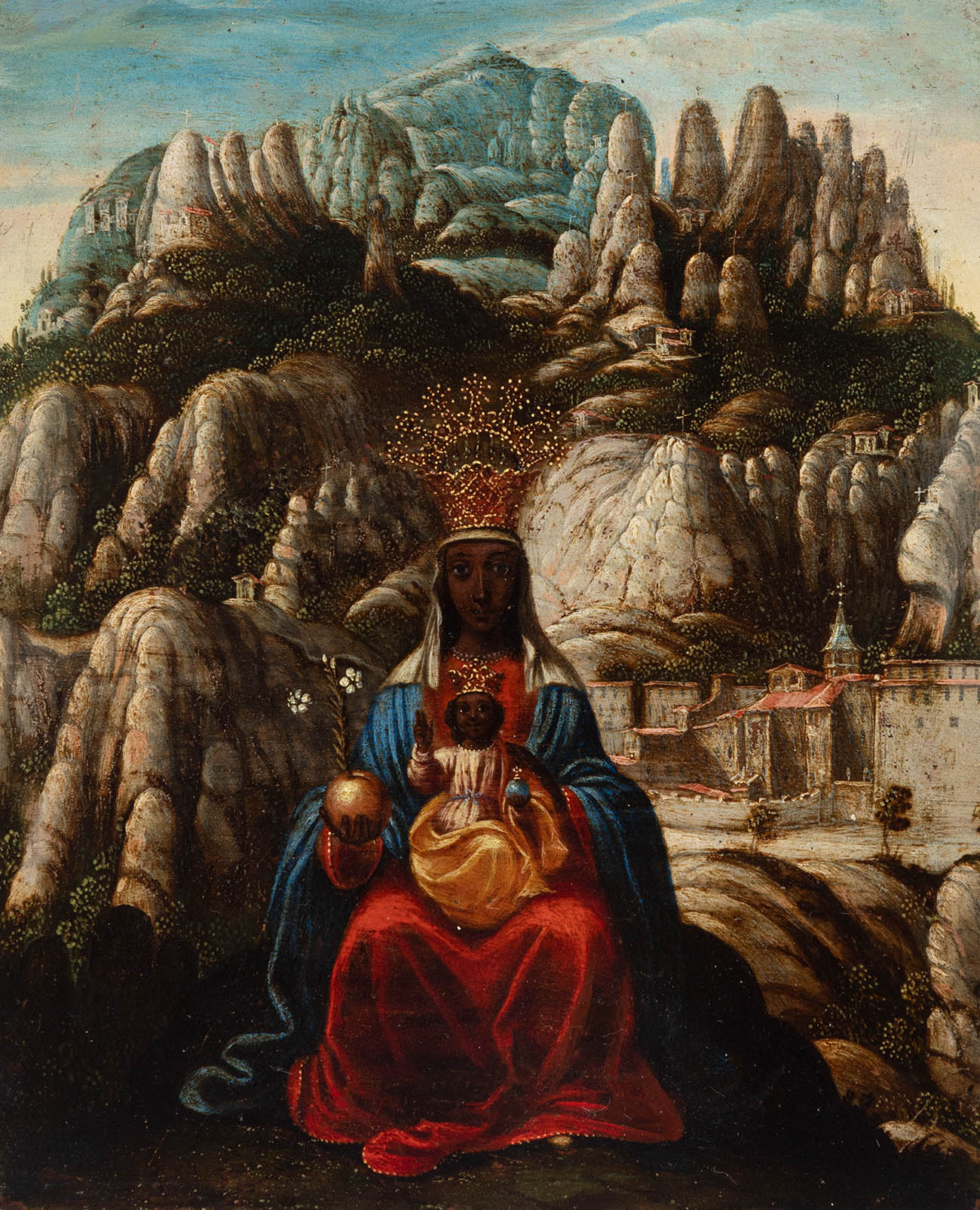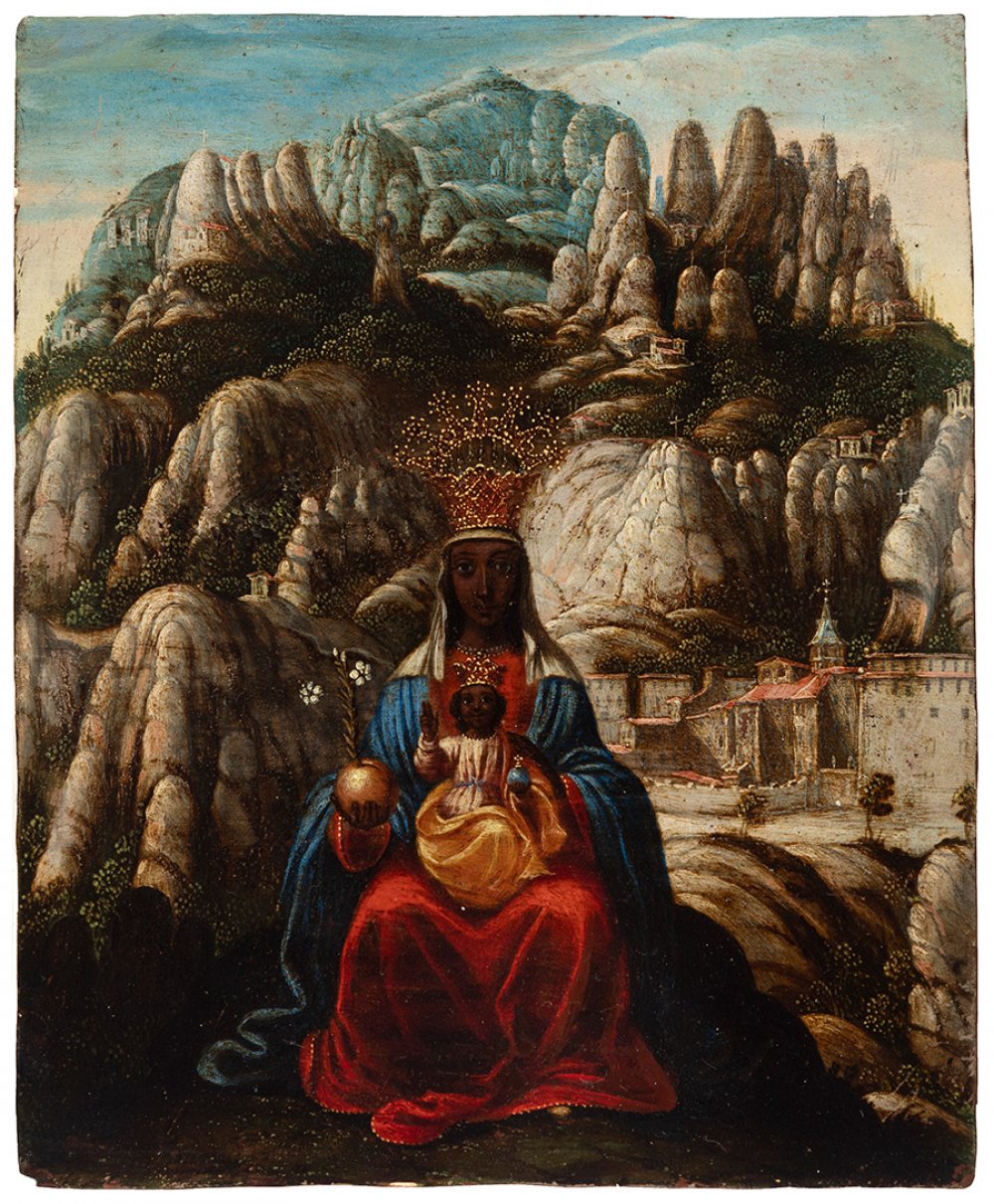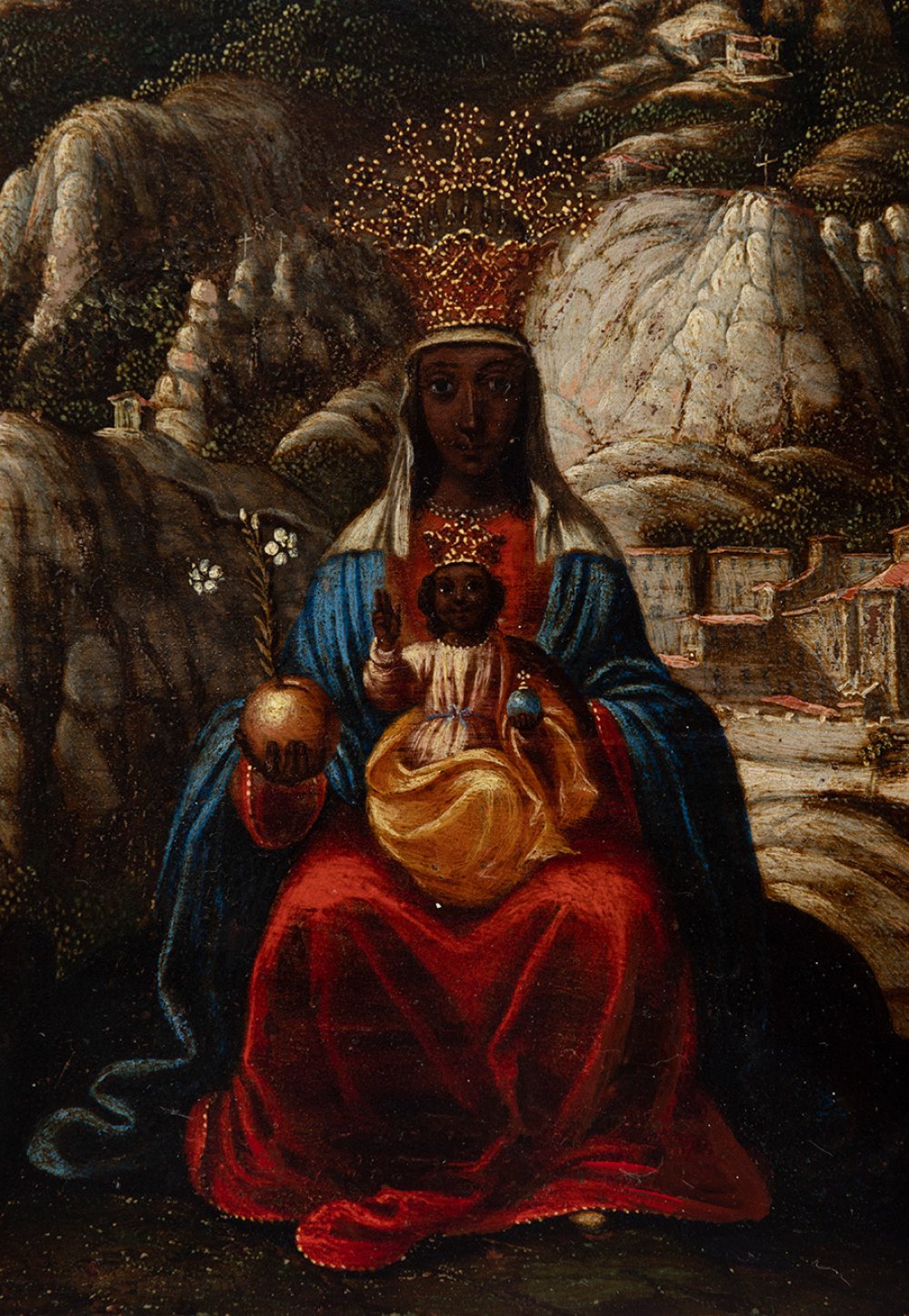13
JUAN ANDRÉS RICCI (Madrid, 1600-Montecassino, 1681)."La Moreneta".Oil on copper.Size: 16,5 x 13,5
"La Moreneta".
Oil on copper.
Size: 16,5 x 13,5 cm.
The painter Juan Andrés Ricci entered the Benedictine monastery of Montserrat in 1627 to study theology. His intellectual development went hand in hand with his pictorial evolution. Here we see a representation of the Virgin of Montserrat (the Moreneta) with the child on her lap, as in the original sculpture, although the painter added sumptuous crowns and bunches of lilies. Behind the Maternity, the unique mountainous terrain is depicted following Flemish models, as can be seen in the use of rich blue and cerulean shades and in the botanical detail.
A painter and theoretician from a family of artists, he was the son of the painter Antonio Ricci de Ancona, who came to Spain to work at El Escorial with Federico Zuccaro and stayed permanently in Madrid, and brother of Francisco, painter to the king in 1656. He must have been educated alongside his father, although Palomino also describes him as a pupil of Maíno. The treatise writer also mentions the success of his paintings at court. However, Ricci left the court to enter the monastery of Montserrat. On entering the Benedictine order he began his intellectual training, which was compulsory for the followers of Benedict of Nursia. He studied theology at Irache and law at Salamanca. All this provided him with a genuine scholarly knowledge which he exploited in his writings on art. A connoisseur of several ancient and modern languages, he called, very much in line with the times, for the liberality of painting, especially in his treatise La pintura sabia (1660-1662), dedicated to the Duchess of Béjar. This text follows the tradition of Alberti in requiring the painter to study geometry, perspective and anatomy, to which he adds the essential role of painting as a disseminator of the religious image, making the painter an emulator of the Deus pictor. All this is accompanied by beautiful drawings in which his knowledge of architecture is also evident. In 1641 he was already away from Montserrat and, after being appointed drawing teacher to Prince Balthasar Charles, he was removed for political reasons. From then on he made several trips to the Castilian monasteries of the order, which he combined with stays in Madrid. He continued to work as a painter in all of them. The best preserved groups of works by the artist are those of San Millán de la Cogolla and the transept of Burgos cathedral. In 1662 he moved to Rome, where he stayed for several years, coming into contact with Pope Alexander VII and Christina of Sweden, to whom he dedicated a new architectural work. In 1667 he was already in the famous monastery of Montecassino, where he continued to work on both painting and writing. His painting evolved very little, remaining far removed from the novelties imposed at court or those he would later discover in Italy. Although his brushstrokes are loose and reflect a great freedom of touch, the most successful aspect of his work is the great severity of the figures in his monastic cycles. To this must be added the exceptional portrait of Fray Alonso de San Vítores in the Museo de Burgos.
"La Moreneta".
Oil on copper.
Size: 16,5 x 13,5 cm.
The painter Juan Andrés Ricci entered the Benedictine monastery of Montserrat in 1627 to study theology. His intellectual development went hand in hand with his pictorial evolution. Here we see a representation of the Virgin of Montserrat (the Moreneta) with the child on her lap, as in the original sculpture, although the painter added sumptuous crowns and bunches of lilies. Behind the Maternity, the unique mountainous terrain is depicted following Flemish models, as can be seen in the use of rich blue and cerulean shades and in the botanical detail.
A painter and theoretician from a family of artists, he was the son of the painter Antonio Ricci de Ancona, who came to Spain to work at El Escorial with Federico Zuccaro and stayed permanently in Madrid, and brother of Francisco, painter to the king in 1656. He must have been educated alongside his father, although Palomino also describes him as a pupil of Maíno. The treatise writer also mentions the success of his paintings at court. However, Ricci left the court to enter the monastery of Montserrat. On entering the Benedictine order he began his intellectual training, which was compulsory for the followers of Benedict of Nursia. He studied theology at Irache and law at Salamanca. All this provided him with a genuine scholarly knowledge which he exploited in his writings on art. A connoisseur of several ancient and modern languages, he called, very much in line with the times, for the liberality of painting, especially in his treatise La pintura sabia (1660-1662), dedicated to the Duchess of Béjar. This text follows the tradition of Alberti in requiring the painter to study geometry, perspective and anatomy, to which he adds the essential role of painting as a disseminator of the religious image, making the painter an emulator of the Deus pictor. All this is accompanied by beautiful drawings in which his knowledge of architecture is also evident. In 1641 he was already away from Montserrat and, after being appointed drawing teacher to Prince Balthasar Charles, he was removed for political reasons. From then on he made several trips to the Castilian monasteries of the order, which he combined with stays in Madrid. He continued to work as a painter in all of them. The best preserved groups of works by the artist are those of San Millán de la Cogolla and the transept of Burgos cathedral. In 1662 he moved to Rome, where he stayed for several years, coming into contact with Pope Alexander VII and Christina of Sweden, to whom he dedicated a new architectural work. In 1667 he was already in the famous monastery of Montecassino, where he continued to work on both painting and writing. His painting evolved very little, remaining far removed from the novelties imposed at court or those he would later discover in Italy. Although his brushstrokes are loose and reflect a great freedom of touch, the most successful aspect of his work is the great severity of the figures in his monastic cycles. To this must be added the exceptional portrait of Fray Alonso de San Vítores in the Museo de Burgos.
28th September - Old Masters
Sale Date(s)
Venue Address
General delivery information available from the auctioneer
Setdart offers Worldwide shipping
PICK UP IN ROOM: You can come and pick up your lots in our offices (Barcelona, Madrid or Valencia). At the moment of the withdrawal, you will be able to accept the current conditions of the lot by means of a document that you will sign.
YOU CAN SEND ANOTHER PERSON TO PICK UP: This person must present a signed authorization that you can find in our web page by accessing from BUY AT SETDART- LOGISTICS-DOWNLOAD AUTHORIZATION DOCUMENT. You can also send an e-mail with the requested data in AUTHORIZATION DOCUMENT to admin@setdart.com
Important Information
25% buyer´s premium
21% buyer´s premium at www.setdart.com
Terms & Conditions
The maximum period to pay the lots is 7 working days. You can pay either via bank transfer or with credit card through our platform www.setdart.com (we only accept VISA or Mastercard).
BUYER´S PREMIUM: 22% Hammer price + 21% VAT from the buyer´s premium
If your piece has more than 100 years, our Ministry of Culture requires an export certificate in order for the piece to leave the country. Note that if the piece goes inside the EU, there is no cost for the export certificate. If the piece goes outside the EU, there is a cost for the export certificate. You can find more information in our Ministry of Culture website: https://www.culturaydeporte.gob.es/en/cultura/patrimonio/exportacionimportacion/exportacion/tasas.html
INQUIRIES: admin@setdart.com
Setdart guides you through the entire process, from the time of award to the day you receive your lot. Our logistics team will be happy to manage your transport, and will advise you on the best shipping method with professionals from the sector used to handling works of art and jewelry.
WE OFFER WORLDWIDE DOOR TO DOOR SHIPPING
PICK UP IN ROOM: You can come and pick up your lots in our offices. At the moment of the withdrawal, you will be able to accept the current conditions of the lot by means of a document that you will sign.
YOU CAN SEND ANOTHER PERSON TO PICK UP: This person must present a signed authorization that you can find in our web page by accessing from BUY AT SETDART-LOGISTICS-DOWNLOAD AUTHORIZATION DOCUMENT. You can also send an e-mail with the requested data in AUTHORIZATION DOCUMENT to admin@setdart.com
SETDART IS NOT RESPONSIBLE FOR THE STATE OF THE PARTS ONCE THEY LEAVE OUR FACILITIES. MRW SHIPMENTS: Once the payment is made, your lot will be packed for shipment, the logistics department will send you an e-mail notifying you of the day it leaves our warehouse, changes of address cannot be made after receiving this e-mail.
INSURANCE INCIDENTS: Coverage for the value of the auction up to 3000 ? per shipment, if the value of the auction is higher, Setdart will send you a quote including the additional insurance. The insurance company WILL NOT BE RESPONSIBLE FOR THE SHIPMENT THAT EXCEEDS THAT AMOUNT AND IS NOT FULLY INSURED. MRW INCIDENTS: Maximum notification 48 hours after receipt, after which the insurance company WILL NOT BE RESPONSIBLE AND NO CLAIMS WILL BE ACCEPTED.
E-MAIL LOGISTICS: logistica@setdart.com
PICK UP YOUR MESSAGES: You can send your own messaging, prior notice via e-mail that your shipment is ready, please note 3 or 4 days in advance. This type of shipment is packaged so Setdart will provide you with a quote.
EXPENSES FOR STORAGE: We inform you that if the purchased lot is not picked up within a month, you will be charged 30€ per week per lot. Setdart Online S.L., owner of the web site "setdart.com", "setdart.net" and "setdart.org", acts as a company of Spanish nationality inscribed in the Volume 36955, sheet 182, page B-293056 of the Mercantile Registry, with registered office at Calle Aragó












